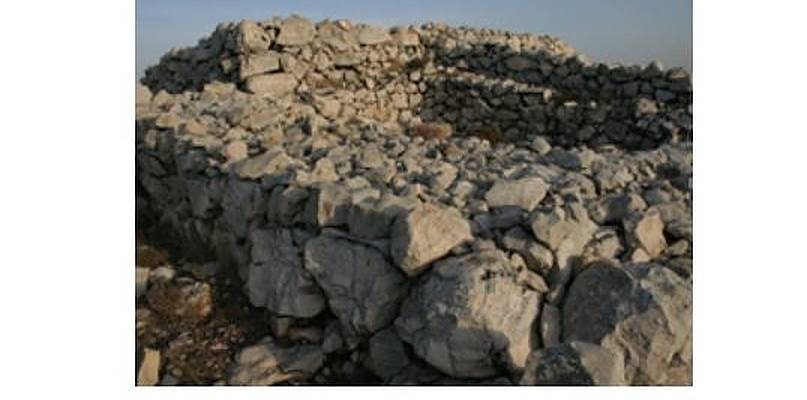
“And it will be, when the Lord, your God, will bring you to the land to which you come, to possess it, that you shall place those blessing upon Mount Gerizim, and those cursing upon Mount Ebal (Deuteronomy 11:29)”
“Then Joshua built an altar to the Lord God of Israel on Mount Ebal (Joshua 8:30)”
By Nosson Shulman, Licensed Tour Guide
Today we are visiting Mount Ebal, a special biblical site (whose structure is mentioned explicitly in the Bible). This site is breathtaking, but seldom visited due to certain security concerns and its unique geo-political location. In order to visit, one must have an IDF escort. While the nearby Tomb of Joseph (for more on that site, click here) also requires an IDF escort, a monthly escort is arranged in advance.
Mount Ebal has no set schedule, rather one has to arrange for it privately. Getting IDF permission can take several months. However, the privileged few who get to visit are certainly happy that they made the effort!
Even before the Children of Israel entered the Holy Land, Mount Ebal was chosen to be the site of a prominent Biblical event. Moses told the people that when they were to cross the Jordan River into Israel, there would be opportunities for blessings (if they listened to and followed G-d’s commandments) or curses if the opposite, G-d forbid, was done. The actual blessings and curses were to be pronounced on Mount Gerizim (blessings) and Mount Ebal (curses) immediately upon entering the land (see Deuteronomy 11).
In Deuteronomy 27, Moses commanded that when the Children of Israel arrived, half the tribes (Simon, Levi, Judah, Issachar, Joseph, and Benjamin) would stand on Mount Gerizim and the other half (Reuben, Gad, Asher, Zebulun, Dan, and Naphtali) would stand on Mount Ebal. In the valley between the two mountains (the city of Shechem) the Levite Elders formed a circle around the Kohanim (Priests), who in turn stood in a circle around the Ark of the Covenant.
The Levites in the valley turned to the tribes on Mount Gerizim and proclaimed a blessing (the first of which was “Blessed be the man who does not make a graven or molten image”) to which the tribes on both sides answered “Amen.” They then turned towards the tribes on Mount Ebal and issued a curse (the first one being “Cursed be the man who makes a graven or molten image”) to which the tribes on both mountains answered “Amen.” They would continue in this fashion with the rest of the blessings and curses.
Upon entering the land, Joshua immediately brought the people to Mount Ebal (and Gerizim) and fulfilled this commandment (see Joshua 8).
In addition to the blessings and curses, Moses commanded that stones be taken from the Jordan River bed that would miraculously split open, allowing the Children of Israel to cross on dry land (For more on this historic event, click here). With the stones, they were to build an altar on Mount Ebal and offer a sacrifice. According to Jewish sources, the reason it was specifically built there was to gladden the hearts of the tribes who were stationed on the mount where curses were directed. When Joshua took the people to Mount Ebal, he built the altar as Moses had commanded and offered an Elevation and Peace offering (see Joshua 8).
In the modern era, explorers and researchers spent much time and effort to locate the altar, but without success. Part of the reason they were unable to find it was because they were looking on the southern slope facing Mount Gerizim (although nowhere in the Bible does it say that the altar was built there). They erroneously assumed that was the location because of all the dramatic blessings and curses uttered there.
Archaeological Evidence for Biblical Account
In 1978, archeologist Adam Zartel began to survey the mountain (meter by meter) but was disappointed that all of the findings were from the Persian Period (5th-4th Century BCE). Towards the end, he found a massive slab of stones and was certain that he had found something special.
Upon his initial surveying, he discovered that the pottery found was from the time of Joshua. Additionally, he found two ancient Egyptian Scarabs from the times of Ramses II, who most historians agree was the Pharoah from Exodus (since the Children of Israel had come with treasure from Egypt, and they were all brought to this area by Joshua, it makes sense that findings like this would be discovered here).
During the excavation (which took him a year and a half), he discovered an altar whose measurements corresponded to the altars discussed in Jewish sources. In addition, only kosher animal bones were found. The animals had been slaughtered according to Jewish law and then burned on an open fire, as required. The archeologist concluded that he had indeed found the biblical altar!
In 1995, Israel gave partial control of this land to the Palestinian Authority (PA) as part of the failed Oslo 2 Accords. Israel retained military control of the mountain because of its strategic location but civil control (including archeological sites) of the mountain was given to the PA, leaving the site at their mercy. Over the years, the site has been desecrated by the locals. In February 2021, the PA government itself breached a millenia-old wall (which surrounded the altar) for roadwork, causing irreparable damage.
Although, technically, non-Israelis are free to visit even without an escort, to do so is considered very dangerous This should NEVER be attempted without first coordinating with (and receiving permission from) the IDF.
For those who still want to experience the site without an IDF escort, there is an amazing lookout point from the Jewish settlement of Elon Moreh. In addition, Mount Gerizim is also fully under Israeli control, and an amazing site to visit in its own right (although prior to visiting, it is always highly recommended to check out and see if there are any security issues that need to be considered at that particular time).
Nosson Shulman is a journalist and Licensed Tour Guide in Israel specializing in Biblical tours. To allow tourists to experience Israel during the Corona era, he created the new hit Israel tour video series which brings Israel to the home of viewers by simulating actual tours. To check out his free sneak preview tour videos, click here. To view sample tour itineraries or to inquire about private tour opportunities with a personalized itinerary on your next trip to Israel, click here.



